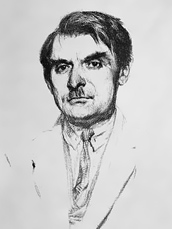
Russian painter, graphic artist, engraver and
illustrator.
He studied at the Penza Art School (1899–1901), the
Kiev Art School (1901–1902) and, in 1903, was admitted to the Academy of Arts
where he studied under Ian Tsionglynsky, Hugo Zaleman and Grigory Myasoyedov.
He learned the engraving technique under Vasily Mathe (1905-1907). He created easel decorative
prints, colour linocuts, colour woodcuts and colour etchings. He was one of the
first artists to get interested in the colour engraving technique establishing
it as an art in its own right, equal to painting. He skillfully broadened the
potential of colour and black-and-white engraving depicting in his works the
wealth of the colours of nature and environment.
In 1905, he produced the first colour woodcuts – Kosary [“Mowers”], Veter [“The Wind”], Groza
[“The Thunderstorm”] and linocuts – Ozero
[“The Lake”] and Spyaschii Kucher
[“The Sleeping Coachman”].From 1907, he traveled in Europe
where he studied history of art. He worked in Italy (1911) as a holder of
fellowship from the Academy of Fine Arts, did prints of renowned masters’
paintings and created his best works – Ulitsa
na Capri nochyu [“A Capri street at Night”], Vinograd [“Grapes”] and Starye
vorota na Capri [“Old Gates in Capri”].
After coming back to St. Petersburg he worked for
publishing houses and made post card prints. In 1916, he moved to Moscow. In
1917, he created a series of etchings and linocuts – commissioned by Alexey
Schusev – depicting construction of the Kazan railway station, the Sights of Rome etching series as well as
about 20 linocuts and 30 etchings – portraits of his friends and relatives. He
created the Dozhdi [“Rains”] album in
the dry-point technique (1918–1919), Po
Italii [“Across Italy”] linocuts series (1921) as well as numerous
litoprint portraits. He worked extensively in magazine and book graphics,
specifically, made the cover for the Rabochii
mir [“Workers’ World”] magazine (1919) and illustrations to Paganini by Vladimir Volkenstein (1920),
O-Tao by Mikhail Morozov (1921), Mutnoye vino [“Turbid Wine”] by
Elizaveta Sturskaya (1922).
Falileyev took part in exhibitions of the Mir iskusstva [“The World of Art”]
Society (1921), the Union of Russian Artists (1906), the Zhar Tsvet [“Live Colour”] Society (1923) and the Assotsiatsia khudozhnikov revolutsionnoy Rossii
(AKHRR) [The Association of Revolutionary Russia’s Artists] (1924).
He displayed his works at the “25 Years of Lithoprints in Russia” exhibition
(St. Petersburg, 1923), the Russian Art travelling exhibition in the USA and
Canada (1924-1925), the International Exhibition of Modern Decorative Art in
Paris (1925), “10 Years of Woodcuts in Russia” (1927), “Colour Xylography. Its
Methods and Potentialities” (1929), and others.
He taught at a women’s
polytechnic (1918), was professor of the Strovanov Art and Technology School
(1918), dean of the Graphics Department and professor of the Lithography Studio
with VHUTEMAS [the Higher Art and
Technical Studios] (1920–1924). In 1924, he
left the Soviet Union and lived in Stockholm, Berlin and Rome.
